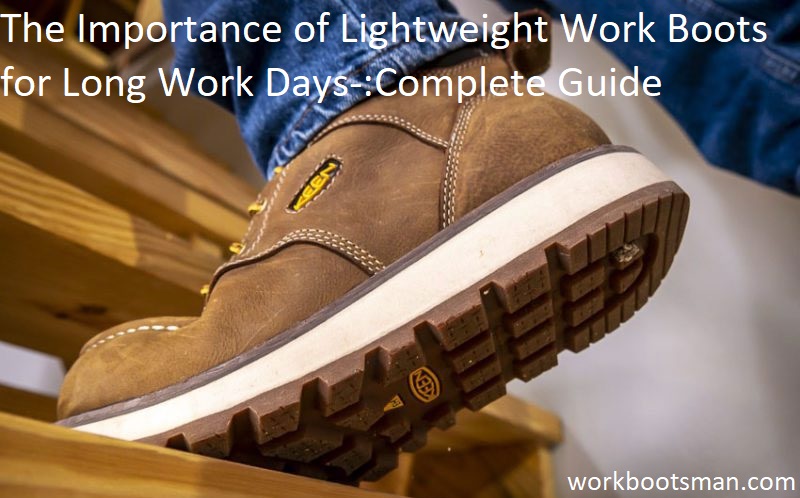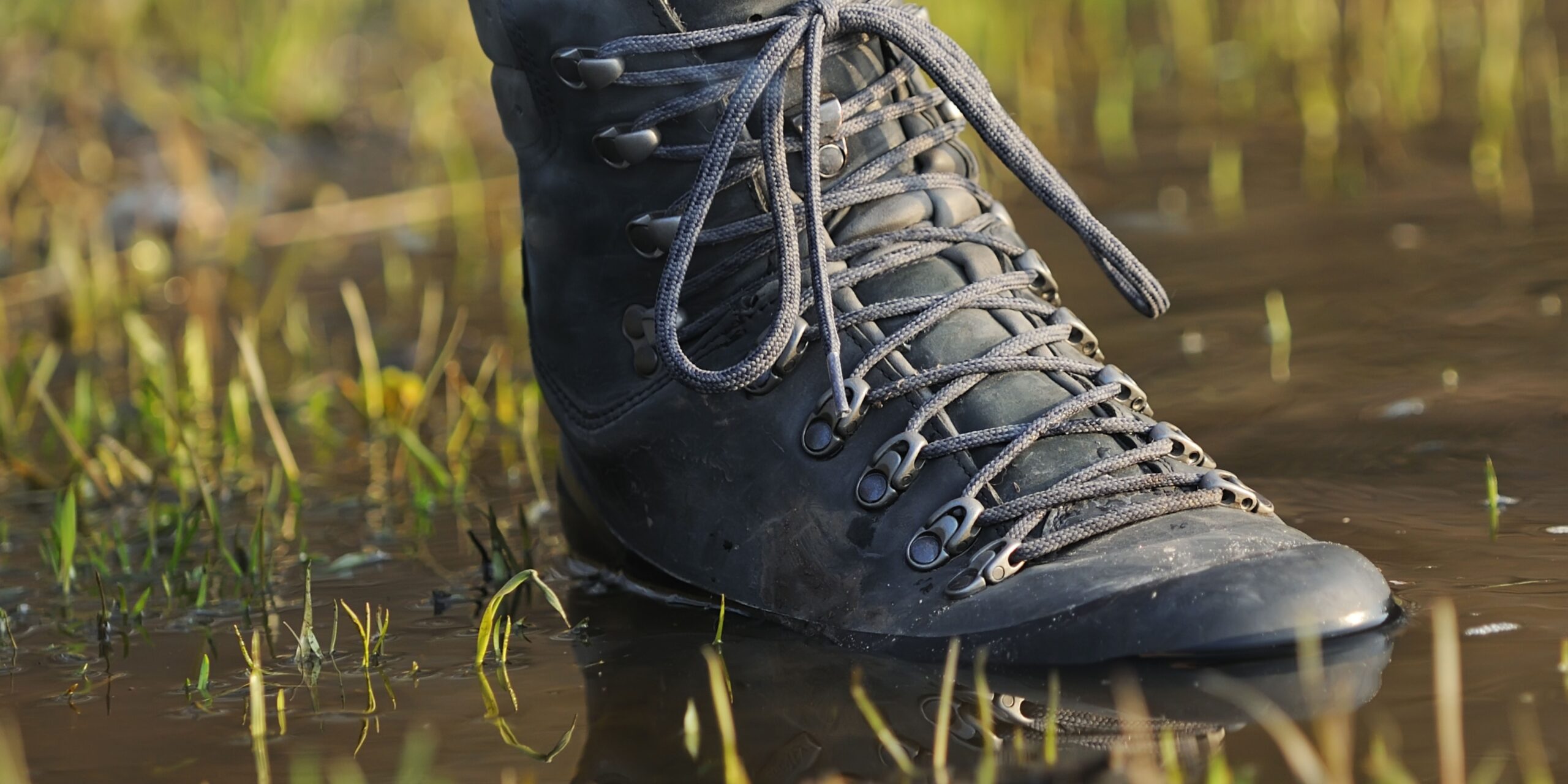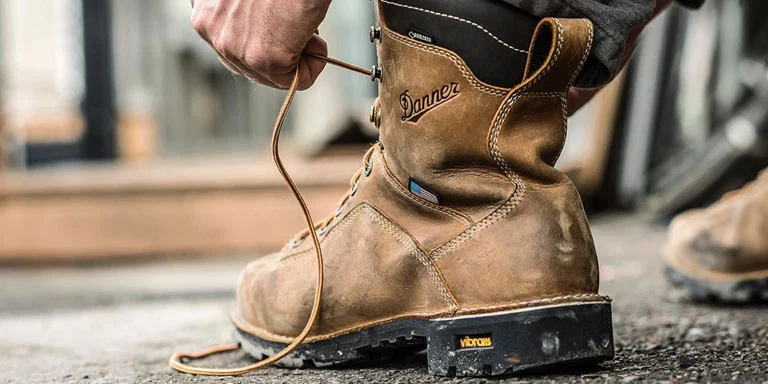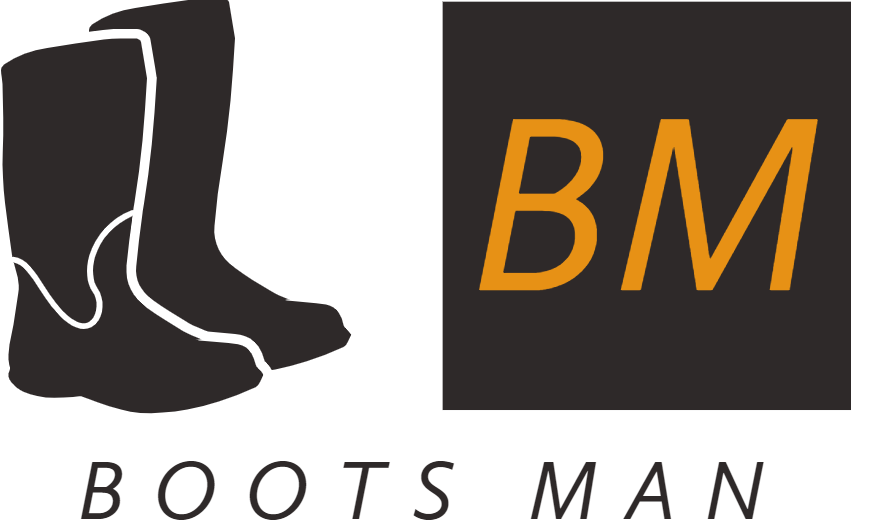Are you looking for work boots that will keep you comfortable and supported during long working days? Look no further! This comprehensive guide highlights the importance of lightweight work boots for lasting comfort throughout your shift.
You’ll learn why lightweight boots are best for reducing foot fatigue and protecting your feet.
When you work long hours, it can be hard to stay comfortable and safe, which is why lightweight work boots are essential for any job that requires a lot of walking or standing. Lightweight work boots provide superior protection without compromising on comfort. They are designed with features such as impact resistance, stability, shock absorption, and insulation to keep feet comfortable no matter how long the day.
Lightweight work boots are designed to keep your feet safe and supported while still being lightweight enough to ensure your comfort level remains high throughout the day. The construction of these boots allows them to remain lightweight while still providing superior protection and comfort. This complete guide will help you choose the best lightweight work boot for any job – from light industrial to heavy-duty jobs – so you can always find the perfect fit.

Benefits of Lightweight Work Boots
Lightweight work boots offer multiple advantages for those who spend long days on their feet. Not only are lightweight boots significantly easier to wear and move in, they can also help to reduce fatigue and prevent foot-related injuries due to overexertion. Here are some of the top benefits of choosing a lightweight shoe when selecting a work boot:
-Increased Mobility: Lightweight work boots allow wearers to move more quickly and fluidly, which reduces the risk of sprains or other injuries caused by slips and falls due to overexertion. This improved mobility also helps reduce job times.
-Enhanced Comfort: Lightweight construction reduces strain on the feet, ankles, and legs, resulting in less fatigue during long shifts. This allows workers to better perform mentally challenging tasks as well as physically demanding ones.
-Improved Safety: Lighter weight shoes provide more traction and stability than heavier models do on slippery or uneven surfaces. Heavy footwear can cause slippage on these surfaces, which increases the risk for serious accidents occurring.
-Preservation of Energy Levels: Wearing these types of boots over long periods prevents wearers from having their energy levels sapped too quickly, ensuring that they are able to perform their job duties efficiently over a longer period of time with fewer breaks in between.
Comfort and Support
Comfort and support are essential when choosing the right work boots, especially when you’re on your feet all day. Lightweight work boots with a low-profile sole provide optimal cushioning and support, while still remaining lightweight and comfortable.
Generally, they feature a synthetic upper to reduce the overall weight of the shoe, as well as an OrthoLite® or Energize Footbed for superior comfort and cushioning. The outsoles are typically made from shock-absorbing EVA foam or rubber to give you maximum traction in hazardous terrains without stretching or wearing out quickly.
With good arch support and breathable lining, these lightweight safety toe boots can keep your feet feeling fresh even after long days at work.
Reduced Fatigue and Stress on Feet and Joints
It is a fact that the right type of lightweight work boot can make all the difference in reducing fatigue and strain on feet and joints after a long day of hard work. Heavier boots are more likely to cause discomfort as they add stress to already tired muscles and tendons.
Lightweight work boots, on the other hand, give your feet better support while also keeping them comfortable throughout your workday. The decreased weight creates an environment where you don’t feel as if you are lugging around an extra load on your feet. Additionally, certain materials used in lightweight boots are designed with ergonomic features such as heel shock absorption or arch support for added comfort over hours of use. This increases airflow to the foot as well, which helps reduce odors from sweat buildup common with heavier footwear.
Overall, it is essential that you invest in a pair of lightweight quality working boots for long-term foot health and maximum daily comfort.
Improved Mobility and Flexibility
Lightweight work boots also offer unique advantages that many traditional heavy-duty boots can’t match. They have improved mobility and flexibility, allowing the wearer to move around more easily, reducing foot fatigue and improving working performance. This is particularly beneficial in jobs where workers are on their feet for long periods of time and need to move quickly.
The lightweight construction also means that they are not as cumbersome as heavier models, so they can be paired with less restrictive clothing for greater range of motion. Additionally, the lighter weight materials used in lightweight work boots may provide safety features like slip-resistant soles and/or protective toe covers which can withstand drops or punctures.
All these benefits make lightweight work boots an ideal choice for jobs that require a lot of physical activity throughout the day.
Features of Lightweight Work Boots
When it comes to selecting a good pair of lightweight work boots, there are certain features that you should look for. Lightweight work boots should not only provide you with the protection and comfort that you need while on the job, but they should also be easy to move around in and not cause additional fatigue. Here are some of the most important features to consider when choosing your lightweight work boots:
Material: The material of your lightweight work boots is very important in providing both warmth and breathability. Lightweight fabrics can help reduce sweating while still being durable enough to protect your feet. Look for water-resistant material such as canvas or synthetic leather as these are better at protecting your feet from water and dirt penetration.
Insulation: Insulated workboots can help keep your feet warm during colder seasons without making them heavy or bulky. Look for insulated materials such as Thinsulate which are lightweight but able to provide the necessary warmth and breathability needed for long days on the job site.
Grip: It is essential that the sole of your lightweight work boot provides added grip on all surfaces, including slippery and uneven terrain, so that you do not slip or fall when walking around or performing physical activities onsite. Rubber soles typically provide better grip than leather soles so consider this when looking for a quality pair of durable yet lightweight work boots.
Shock Absorption: Long hours onsite often require extra cushioning and shock absorption in work footwear due to reduced fatigue levels over time – this is especially true if you’re working with heavy tools or equipment consistently throughout the day.. Look for shoes with midsoles made from reinforced foam or rubber which will absorb shocks much better than regular materials commonly found in other types of footwear.
Materials
When it comes to choosing the right work boot, the material is of utmost importance. This can dramatically impact the comfort, durability, and safety of your work boots. Generally speaking, there are three common materials used to make lightweight work boots: rubber, leather, and synthetic fabrics.
Rubber Work Boots – Often used in heavy duty or industrial environments due to their waterproof feature and resistance against chemicals or hazardous elements such as oil. Rubber boots are also naturally quite flexible on the outsole which essentially makes them comfortable enough for long hours on your feet.
Leather Work Boots – The greatest advantage of leather work boots is their durability. Not only are they sturdy but they can often withstand wear and tear better than other materials like rubber and synthetics. As a result, leather work boots usually last longer than other materials so you can expect them to last you years if taken good care of it.
Synthetic Fabrics Work Boots – Synthetic fabrics such as nylon blends bring forth several advantages over rubber and leather that make them an ideal option for lightweight and durable options for long days on your feet. Generally speaking, these types of materials tend to be much easier to clean than most traditional materials making it easy to keep up with workplace cleanliness protocols inside the office or workplace.

Design
The design of a good lightweight work boot is an essential factor when it comes to comfort and safety. Many boots contain features that can help to improve their overall performance. Some features to look out for include:
- Arch support – Lightweight work boots should be designed with arch support, which offers stability and reduces strain on the feet, allowing the user to stand for long periods of time without fatigue.
- Padding – Contoured padding such as memory foam can provide extra cushioning and help to reduce shock absorption while also providing overall foot comfort.
- Toe protection – The toe box should be reinforced with durable material in order to provide protection against bumps and scrapes. Additionally, protective toe caps help keep feet safe in hazardous conditions.
- Outsole – It is important for outsoles to be made from slip-resistant rubber materials so that workers can stay steady during slippery or wet conditions. Additionally, diagonally cut lugs enhance traction on a variety of terrain surfaces.
- Ankle support – High-top boots offer additional ankle coverage and help keep the foot stable when performing physical activities such as climbing ladders or bending down often.
Safety Features
When selecting a lightweight work boot, safety should also be taken into consideration. Many lightweight boots offer additional features that provide enhanced protection while working and include steel toe protection and waterproofing.
Steel toe – Many lightweight boots include protective steel toe caps that provide extra protection to the delicate toes and soles of the feet. Steel toe caps can reduce the chance of crushing or penetrating injuris and are ideal for workers in hazardous jobs.
Waterproofing – Lightweight work boots often feature waterproof leather upper which can protect against moisture, snow, and dust on the job. Waterproofing technology offers complete water resistance for working in wet or rainy conditions as well as allowing sweat to escape from the feet, keeping them dry and comfortable throughout a long day’s work.
Maintenance and Care
In order to help ensure that your lightweight work boots maintain their quality and last, proper maintenance and care are essential. It’s strongly recommended that you clean the boots after each use. This should include brushing off caked-on dirt on the upper with a soft bristle brush. You should also gently wash the leather with a damp sponge and mild soap solution, taking special care not to get the inside of the shoe wet, as this will create a breeding ground for bacteria. After washing, be sure to wipe off any excess moisture with a dry cloth and then let the boots air-dry away from heat sources or direct sunlight.
To preserve flexibility, look for leather conditioners that contain mink oil or Madeira oil for an extra layer of protection against weather elements such as wind, rain and snow. If desired, you can also add water-resistant spray or wax treatments after applying conditioning creams or oils. Lastly, if you have removable insoles in your work boots, take them out every once in a while to ensure they are clean and dry prior to being replaced back in the shoe.
Following these simple steps will protect your work boots against wear and tear while you remain safe throughout your long work days!
Cleaning and Maintenance
Cleaning and maintaining your lightweight work boots properly is a key factor to extending the life of your investment. It helps them stay in top condition and perform better, while also ensuring they not only look good but are durable.
Here are a few tips to keep in mind when caring for your lightweight work boots:
- Wash mud or dirt off with a soft brush
- Air dry them away from direct sunlight or heat sources
- Use a leather conditioner once or twice per month to help maintain the material’s flexibility
- Stuff newspaper into wet work boots, to help them keep their shape while they dry
- Use waterproofing spray on the outside of your boots regularly, especially if you are frequently working around water.
Proper Storage
It is important to remember that all of your footwear—not just lightweight work boots—needs to be properly stored when not in use. Storing your footwear correctly helps preserve their shape, integrity, and even breathability over time.
For lightweight work boots in particular, proper storage means that you don’t want to store them in a location where there is too much humidity or too much heat. If possible, try to store them out of direct sunlight and a temperature-regulated area like a closet or cabinet. You should also avoid keeping them in a plastic bag for too long – try swapping it out with newer ones on occasion. Additionally, ensure that you keep the laces off when storing them. Instead of folding the laces up and placing them inside the boots, tie the laces together and keep them outside since they get soiled quickly if they are left inside the boots for long periods of time.
Finally, if you find yourself in a humid climate or need extra ventilation for your boots try placing paper towels, newspaper clippings or cedar blocks inside the toes and heels as an additional form of breathability control that not only won’t damage your shoes but also absorbs moisture – leaving your boot dry every day!

Conclusion
At the end of the day, finding the right pair of lightweight work boots is essential for any professional who spends long days on their feet. A good pair of lightweight work boots should provide comfort and stability while still giving you enough cushioning and shock absorption to keep your feet safe.
Ultimately, you want to find a pair of shoes that provide the best combination of these elements at a price point that works for your budget. It’s important to do a bit of research and make sure that you are buying boots that offer both quality components and well-informed construction. Taking these steps will ensure a comfortable fit over prolonged wear, improved performance during your intense workdays, and greater protection against potential hazards in the workplace.
FAQs
Why are boots important in the workplace?
Boots are important in the workplace as they provide protection to the feet against various hazards, such as falling objects, slippery surfaces, electrical hazards, and more.
What are the lightest work boot?
There are many lightweight work boots available in the market, including the Timberland PRO Men’s Pitboss, Wolverine Men’s Overpass, and Reebok Work Men’s Rapid Response.
Are work boots good for standing all day?
Yes, work boots can be good for standing all day as they provide proper support, cushioning, and stability to the feet, reducing fatigue and foot pain.
What are the advantages of boots?
The advantages of boots include protection, support, comfort, durability, and style. They are also suitable for various weather conditions and work environments.
How do boots motivate their employees?
Boots can motivate employees by making them feel safe, comfortable, and confident in their work environment, which can lead to higher productivity and job satisfaction.
Is it good to wear boots to work?
It depends on the nature of the work and the dress code of the workplace. If the job involves physical labor or hazardous conditions, wearing boots can be beneficial.
Are work boots necessary?
Work boots are necessary in many workplaces where there is a risk of foot injuries, such as construction sites, factories, warehouses, and more.
What are the safety features in work boots?
Safety features in work boots can include steel or composite toe caps, slip-resistant outsoles, electrical hazard protection, puncture-resistant soles, and more.
Do light boots make you faster?
Light boots can make you feel lighter and more agile, but they may not necessarily make you faster. Speed depends on various factors, including physical fitness, training, and technique.
What does lightweight mean in shoes?
In shoes, lightweight means that the shoes are designed to be lighter in weight than traditional shoes, which can provide greater comfort, agility, and speed.
See Also:
- Best wellington work boots 2023
- Best women’s boots for farm work 2023
- Best women’s pull on work boots 2023
- Best work boots for ankle support 2023
- Best work boots for asphalt 2023

